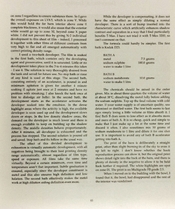That's how I read it. But I'll admit it's not clear.
Further down in the article, after giving the formulas for each baths, Thornton states "Try about 4 minutes in each at about 21º C for roll films; 5 for sheet"—which seems to imply that you should (or can) agitate after three minutes. But earlier, in the part I quoted, he indicates that "all development has ceased" after three minutes "or so". Now why keep the film in the developer for one to two aditionnal minutes if "all development has ceased"?
There are a few old threads on Dixactol on Photrio.
Maybe all the highlight development has ceased but the low and mid values continue some more, but then, that goes against "all development has ceased" comment. In The Negative, AA said a variation of the two-solution process, would be to develop the film to N-1 or N-2, which that in itself implies like you would in a single bath..............then, allow the film to "stand in the alkali bath for several minutes to reinforce the shadow densities." This implies to me that not all the development has ceased.













